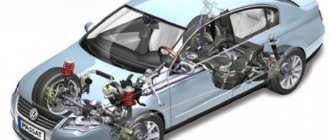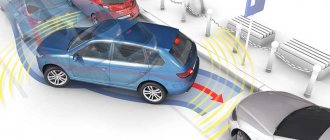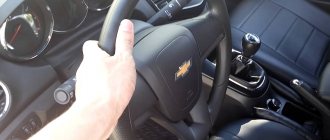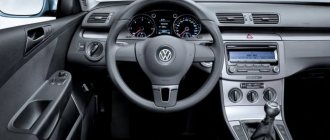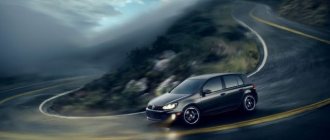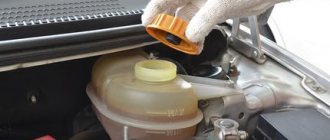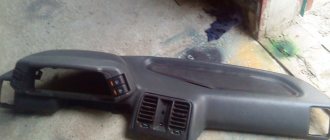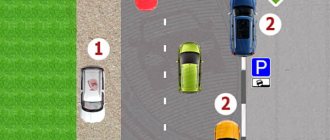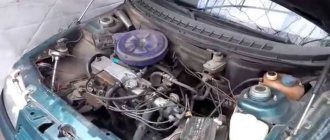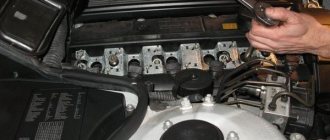It’s not difficult to learn how to drive off with a manual after an automatic. Novice drivers are often simply afraid to drive such a car, because it requires a special attitude.
In an automatic transmission, the entire process of switching the transmission is carried out by a computer, while in a manual transmission, control of the car falls entirely on the driver.
In this article we will try to help you master a car with a manual transmission. We'll tell you about ways to get moving with a manual transmission, step by step for dummies we'll analyze all the stages of starting to move a car with this gearbox. Let's consider the nuances associated with switching speeds, as well as other useful topics. But first, let's talk about the advantages and reasons for the popularity of this transmission.
Advantage of a car with manual transmission
A car with a manual gearbox (hereinafter referred to as manual transmission) has a number of advantages:
- usually accelerates faster than a car with an automatic transmission;
- has lower fuel consumption;
- has a low repair cost in case of gearbox failure.
A manual transmission is structurally simpler than an automatic one, which also affects the cost of the car - on average, it will be 30% lower than a car of the same model and configuration, but with an automatic transmission.
On the downside, manual transmission makes life difficult for novice drivers. During the control process, they have to control the engine speed, change gears in time, and starting to move at first is a completely impossible task.
This is why standing start is given special attention in training.
The role of the clutch in a car
To learn how to move off manually, you need to understand the operating principles of this box. The clutch in a car with a manual transmission acts as an on/off switch, disconnecting the engine from the transmission. When the left pedal is fully pressed, the connection between these components of the car is broken, at which point you can change gear. Smooth running at the beginning of movement is also ensured by the clutch.
Difficulties and errors when driving a manual transmission are associated with incorrect operation of the clutch pedal. The driver needs to bring all movements to automaticity, including starting from a standstill.
In addition, you need to remember the positions of the gearshift lever corresponding to certain gears, and when driving, shift them without looking. This is achieved by a simple exercise: with the engine turned off and parked on a level surface, depress the clutch pedal, engage first gear, and smoothly release the pedal. Such movements are repeated for all gears.
What is manual transmission?
A manual transmission is a unit that is connected to the engine and transmits torque to the wheels of the car. Transmission can be carried out from the gearbox directly, through a driveshaft, gearbox or an entire axle.
A distinctive feature of the manual transmission is the clutch, which provides a rigid connection with the engine flywheel. This leads to difficulties with driving, and in particular when starting to move, when everything needs to be done smoothly without stalling.
How to get going quickly is a question that worries many novice drivers. Mastering this technique can only be achieved through practice, but such knowledge must be supported by theory.
Is it possible to start using the clutch without gas?
On most modern cars, you can start driving without using the gas pedal. The driver depresses the clutch, starts the engine, engages first gear and slowly releases the pedal. A serviceable vehicle will then begin to move slowly.
To prevent the car from jerking, the clutch is released smoothly, millimeter by millimeter. It is important to catch the moment when the car shakes and starts moving. Here you can fix the pedal (stop lowering it) so that your foot “remembers” the position.
Experienced drivers know how much to release the pedal to start moving without jerking and not stall, and they do it quickly.
How to start driving a manual car - step-by-step instructions
To understand for yourself how to learn how to properly start with a manual and do it smoothly, you need to choose a large area or a deserted road. It is desirable that there are no significant slopes. Then you can proceed to the simplest exercise:
- Depress the clutch.
- Start the engine.
- Engage first gear.
- Smoothly lift your foot off the clutch pedal until the car starts moving.
- After driving 3-4 meters, you can completely remove your foot from the clutch pedal.
If necessary, you can add gas, or, pressing the clutch again, engage second gear, release the pedal and continue driving.
In this way, many beginners get off the road not only on the racetrack, but also in a real street situation. In a traffic jam, this approach is quite acceptable, but if you need to achieve a quick start, for example, at an intersection, you will have to act differently:
- Depress the clutch pedal.
- Engage first gear.
- Add some gas. You can use the tachometer speed as a guide: when starting from a standstill on a flat surface, 1000–1300 rpm is enough. The steeper the climb, the more rpm you need.
- Smoothly depress the clutch until the car starts moving.
- After driving 3-4 meters, remove your foot from the clutch pedal and add gas.
This way you can start with a manual at a traffic light or in another similar situation. Experienced drivers work with two pedals at the same time: remove the clutch and add gas.
How to start up a hill using manual mechanics
It is more difficult to drive uphill: the slightest mistake leads to the engine stopping and rolling back, which in urban conditions can result in an accident. That is why it is better to practice driving skills in closed and deserted areas, for example on a race track. There are two main ways to start up a hill from a standstill: with the handbrake and with the clutch locked.
Starting movement using the handbrake
When you stop on a slope, immediately put the car on the handbrake - this will help save a lot of nerves. To start moving, use the following algorithm:
- Depress the clutch pedal.
- Engage first gear.
- Smoothly lift your foot off the clutch pedal and watch the tachometer.
- As soon as the tachometer shows 1500–2000 rpm, place your foot on the clutch pedal.
- Release the handbrake all the way down while simultaneously releasing the clutch completely.
If you do everything in this sequence and do not rush, the car will start moving forward and will not roll away.
If necessary, if the climb is steep, you can add gas.
How to start moving with the clutch locked?
It is more difficult to move from a standstill with the clutch locked (without a handbrake), but this also needs to be learned. Here is a different algorithm:
- Hold the car on the slope with the brakes, the corresponding pedal is depressed.
- Depress the clutch. If the engine stalls earlier, turn on the ignition and start the internal combustion engine.
- Engage first gear.
- Release the brake pedal until vibration occurs.
- Now it is important to simultaneously remove your foot from the brake pedal and move it to the gas.
You can add a little gas and finally engage the clutch (remove your foot from the pedal). If the slope is not steep, you just need to take your foot off the brake pedal and the car will start moving.
It is more difficult to drive away with the brakes pressed, but the skill needs to be practiced: they usually find out that the handbrake is faulty at the most inopportune moment.
How to avoid jerks when starting
An uneven, jerky start to movement signals that the driver is not doing something smoothly enough. This could be the clutch releasing too quickly or the engine speed being low (not enough gas).
To avoid jerking at the start, you need to train your left foot: release the clutch smoothly. In addition, the foot must “remember” at what position of the clutch pedal the car begins to move. Novice drivers usually release the pedal almost halfway, then try to fully engage the clutch. The disc is sharply adjacent to the flywheel, hence the jerking.
If the engine speed is not enough, similar problems can also arise. You need to add speed when driving uphill, for a loaded car, or if there is a trailer.
Automatic control during steep climbs and long descents
When driving in difficult conditions, when overcoming a steep climb or when driving on loose snow, the hydromechanical transmission can slip - this is its feature, since there is no rigid connection between the automatic transmission and the engine. In this situation, the driver must help the car by forcibly downshifting in advance.
When driving on a long downhill slope, such as on mountain roads, using only the brake system to prevent dangerous acceleration of the vehicle will result in overheating of the pads, discs or drums. You should forcefully engage the second or even first gear of the automatic transmission to effectively slow down the car.
How to enter an overpass at a race track
The exercise “Moving from a place on an overpass” during the exam is performed in accordance with the regulations. The general principles are similar to those described above, but there are exceptions when stopping and starting on an incline.
Detailed algorithm of actions:
- Climb the overpass to the STOP-1 line.
- Depress the clutch and simultaneously press the brake pedal.
- Raise the parking brake.
- Move the gearshift lever to neutral position.
- Take your feet off the pedals.
- At the examiner’s command, start moving (the method is described above). You must not roll back more than 30 cm.
- Drive over the overpass, stop in front of the “STOP-2” line at the end of the exercise.
From April 1, 2022, the exam at the race track and in the city has been combined into one stage, but this does not mean that you no longer need to practice the “Overpass”. The skills of starting to move uphill will be tested in city conditions.
Common mistakes when climbing a hill
Novice drivers make the same mistakes when climbing a hill:
- They enter the “STOP-1” and “STOP-2” lines.
- Stop at a distance of more than 1 m from the stop line.
- Allows the vehicle to roll back to a distance of more than 30 cm.
Another mistake is a stalled engine. It occurs if you operate the clutch pedal incorrectly: release it too quickly or too early. The same error can occur when driving in urban conditions.
The tasks of careful braking
It would seem that what is so difficult about stopping a car at a traffic light? It is enough to press the brake pedal sharply. However, many factors must be taken into account: road condition, climatic conditions, traffic density, traffic speed, etc. If you brake carelessly, this can lead to:
- Discomfort and injury to passengers. This is especially true for young children and the elderly. The driver himself not only gets used to the frequent jerking of the car, but also always anticipates them. For passengers, each jolt is like a “surprise” that can result in serious bruises and even fractures.
- Uncontrolled driving through a red light on an icy road. It is always important to brake correctly, but especially in winter. If you press the pedal sharply, the car will continue to move on the ice by inertia. If you do this at the wrong time, there is a high probability of meeting the bumper of a car in front or driving onto a section of the road with heavy traffic. No matter how experienced the driver is, an emergency stop at a traffic light in such a situation is impossible.
- Accident involving a car coming from behind. The other driver simply won’t have time to react if you brake sharply, and will inevitably ram the car.
Stopping incorrectly at a traffic light will lead to loss of time, nerves, money, and in the most difficult situations, lives. Therefore, always study the theory and accurately apply the acquired knowledge in practice.
How to drive up a hill in reverse gear
When driving off-road, if there is a steep and slippery hill (for example, due to muddy clay), it is better to “storm” it using reverse gear. The rear gear torque is higher, and on front-wheel drive cars the bulk of the torque will go to the front wheels. There are more chances to rise in the end.
If we are talking about starting up a hill from a standstill in reverse gear, the algorithm is as follows:
- Put the car on the handbrake.
- Depress the clutch.
- Start the engine.
- Engage reverse gear.
- Slowly release the clutch.
- As soon as you feel that the car is about to start moving, lower the parking brake lever down.
- The car should start moving. You can remove your foot from the clutch pedal and, if necessary, add gas.
Extreme caution must be used when moving backwards. Remember to assess the situation behind and in front of the car.
About this article
wikiHow works like a wiki, which means that many of our articles are written by multiple authors. This article was created by volunteer authors to edit and improve it. This article has had 11,457 views.
Categories: Driving vehicles
English:Get Started on a Hill when Driving a Manual Transmission Car
Italiano:Far Ripartire un'Auto in Salita col Cambio Manuale
Português:Arrancar com um Carro de Marcha Manual em uma Rampa
Deutsch:Anfahren am Berg mit einem Auto mit Handschaltung
Français: faire un démarrage en côte avec une voiture à transmission manuelle
Seal
How to start with slipping on mechanics
Fans of aggressive driving, who do not spare their car, often do not know how to move from a place with slipping. There is nothing complicated here: many beginners, due to inexperience, often start moving this way.
The algorithm of actions is as follows (with the engine running).
- Depress the clutch.
- Engage first gear.
- Depress the clutch.
- Add gas (especially aggressive ones reach 3000 rpm)
- Release the clutch so that the car does not stall.
Noise, whistle and delight are guaranteed. Be prepared for the fact that the car may skid. Possible breakdowns include clutch problems and tire wear. The engine resource with this driving style is significantly reduced.
Now you know how to start with a manual car in different situations. If you have problems with this, hire an instructor and practice with him in a closed area or an empty road. Mistakes when starting from a standstill, especially uphill, in dense city traffic will cost the driver dearly.
Share on social networks:
More useful on the topic
How to sign up at the traffic police to take exams to obtain a driver's license
21.02.2022
What you need to get your driver's license in 2022
10.02.2022
Some tips for safe driving
Pulling away without jerking or suddenly stopping the engine is an indicator of the driver’s professionalism. It’s not difficult to learn this, the main thing is to be patient and create the right conditions:
- for training, choose race tracks or empty roads with no traffic;
- move onto roads with heavy traffic gradually;
- Do not neglect the help of specialists; if necessary, take several practical lessons at a driving school.
When driving a car, all maneuvers must be leisurely and deliberate. A manual car is in many ways superior to an automatic car, despite the fact that the demand for computerized cars is growing rapidly every year. All you need for a comfortable ride is to learn to feel the car and remember the rules of the road.
